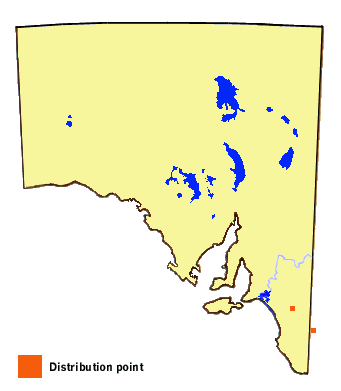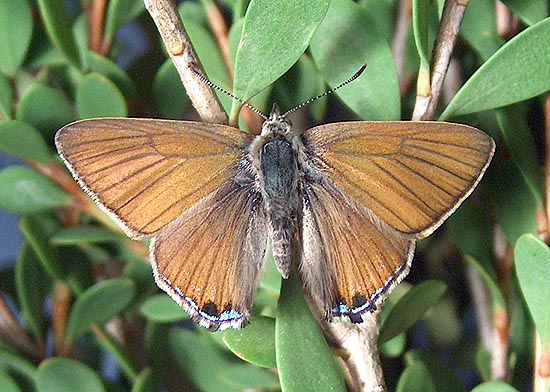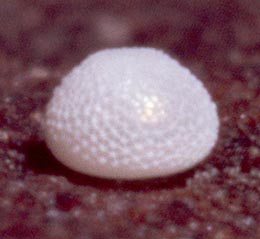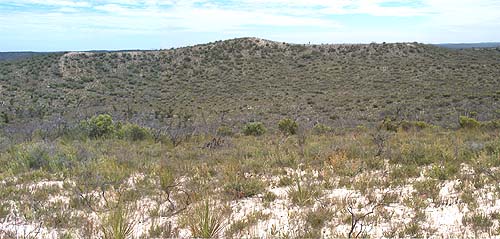Bronze Ant-blue
Acrodipsas brisbanensis (Miskin)
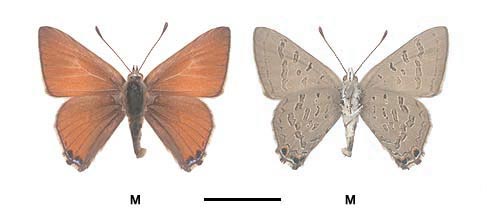
Interesting Aspects
This unusual shaped butterfly belongs to the endemic Australian Theclinae group, which have a very strong association with ants. The hindwings are tornally elongate and 'square' looking, which are particularly accentuated in the females due to their forewings being larger than the hindwings.The males are capable of very fast flight and are nearly always found congregating on pinnacle hill tops (leks) bearing at least one tree or tall bush (dead or alive) at its peak.Earlier in the day (late morning) they tend to fly at a height of about 2 m around the hilltop lek, with a slowed loping flight looking for any newly emerged females with which to mate. Later on they perch with wings folded on the exposed extremities of the bush or tree, usually at its top, and in this situation they are very territorial with each male competing for the best, highest position.Sometimes they will leave the hilltop in the early afternoon to escape the heat, not to return again for the rest of the day, or depending on the individual they may return again in the late afternoon.If the apex of the hill is bare or has been cleared the males will collect on a lower ridge top having similar floral attributes.Sometimes they will collect in the brood area on a prominent tree or bush if it is a major colony. The females are mostly encountered on the same hilltops frequented by the males.Newly emerged females, if they have not already mated with any males occurring in the brood area, will fly to the hilltops to mate with the males, then return to the brood areas (often on the lower flanks of the hill) where they remain, usually separated from the males unless they use the same flowering bush for nectaring purposes.
This is not to say that these butterflies only inhabit pinnacle hilltops (as otherwise there would be no dispersal, leading to the demise of the colony), but rather because of their rarity it is the usual place where they may be encountered by the human observer. The hilltops are a focal point to which both male and female butterflies can easily relate to for courtship (lekking) purposes. This can be partly alleviated by using singularly tall trees adjacent to the colony as a replacement for the hilltops. Without a high-point the butterflies would have to remain near the foodhost and pupation area and depend upon their pheromone dispersal and the detection of the pheromones of the opposite sex for courtship. Since the emergence of opposite sexes from their pupae is not always coincident, then the first emergent butterfly may eventually have to fly off to find flowers for nectaring purposes before the opposite sex has emerged.In doing this, and without a nearby hilltop to which it can navigate by, the butterfly would likely become permanently lost to the colony. Many rare types of butterflies and other insects need to use hilltops for courtship lekking purposes for the reasons mentioned above.
In South Australia, flight seems to be very much dependant on weather conditions, preferring hot (20-33 C), fine parameters with low wind velocities. Males are very placid when settled, but they often perch high up in the crowns of trees requiring binoculars for recognition.Females are very rarely seen.The uppersides of the males have a uniform rich brown colour, whereas the females are dark brown with usually some blue colour covering about half the wing extent. The underside markings of the South Australian population are highly variable, from a clear pattern of small irregular spots and transverse bars edged with white to a pattern with very few spots and no bars. The species is closely related to several other very similar looking species in the Genus Acrodipsas, and about the only reliable means of identification is to examine the underside forewing postmedian transverse bar, which (if present) is broken or dislocated about 1/3 the way in from the anterior (costa) edge of the wing, with the anterior portion of the bar always slightly curved outwards towards the outer (termen) edge of the wing. However, this distinction is also found in A. myrmecophila but this butterfly is smaller and has a different wing shape and underside pattern.
This butterfly was only found to occur in South Australia in 1995.It was not seen again until recently (2007), when females were also seen for the first time. Recent DNA analysis of this butterfly (Eastwood 2002) indicate its molecular attributes are more isolated from the nominotypical eastern states populations occurring along the Great Dividing Range. The males of the local subspecies (including those from west Victoria) are usually pale bronze-brown on their uppersides, similar to a population occurring in Western Australia, and differing to the eastern states populations in which the males are usually dark brown.

